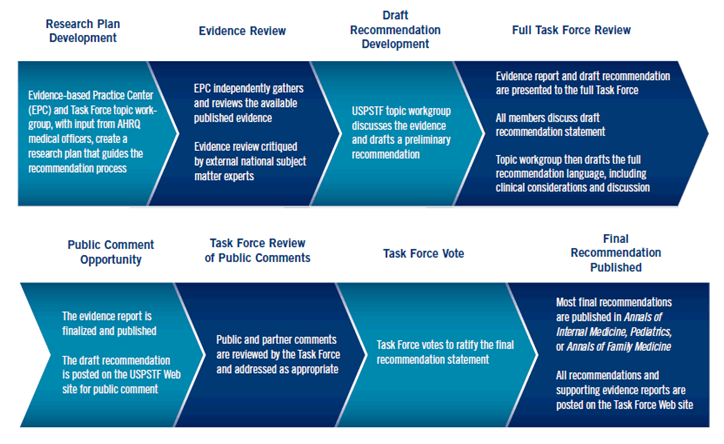About Prevention TaskForce
Prevention TaskForce is a quick, hands-on tool designed to help primary care clinicians and health care teams identify, prioritize, and offer the screening, counseling, and preventive medicine services that are appropriate for their patients. The Prevention TaskForce is based on the current, evidence-based recommendations of the U.S. Preventive Services Task Force (USPSTF) and can be searched by specific patient characteristics, such as age, sex, and selected behavioral risk factors. When using this tool please read the specific recommendation to determine if the preventive service is appropriate for your patient. This tool is not meant to replace clinical judgment and individualized patient care. Available both as a Web-based selector and as a downloadable PDA application, the Prevention TaskForce brings information on clinical preventive services that clinicians need - recommendations, clinical considerations, and selected practice tools - to the point of care.
Some of the tools in the Prevention TaskForce include a BMI calculator, a scoring system for osteoporosis, and topic specific information for patients from www.healthfinder.gov.
Some of the ways the Prevention TaskForce is being used include:
- By primary care physicians and nurse practitioners at San Francisco General Hospital to provide evidence-based support to primary care providers on recommended preventive health services. More Info
- By students at Wichita State University as a way to introduce and emphasize the importance of preventive and evidence-based medicine in the practice of medicine. More Info
- By EHR vendors to improve its care processes by integrating the USPSTF recommendations into its patient workflow. More Info
- By the Office of Disease Prevention and Health Promotion in their myhealthfinder tool. Myhealthfinder is an easy to use tool that patients and consumers can use to search for information about preventive services. It provides searchable, easy-to-understand health advice.
About USPSTF
The U.S. Preventive Services Task Force (USPSTF or Task Force), an independent body of experts in preventive medicine and primary care, works to improve the health of all Americans by making evidence-based recommendations about the effectiveness of clinical preventive services and health promotion. The recommendations made by the USPSTF address clinical preventive services for adults and children, and include screening tests, counseling services, and preventive medicine. The Task Force makes its recommendations based on comprehensive, systematic reviews and careful assessment of the available medical evidence.
The USPSTF comprises 16 volunteer members who are nationally recognized experts in the disciplines of preventive medicine and primary care, including internal medicine, family medicine, geriatrics, pediatrics, preventive medicine, behavioral medicine, public health, obstetrics and gynecology, and nursing. All members volunteer their time to serve on the USPSTF, and most are practicing clinicians.
Since its inception over 25 years ago, the USPSTF has worked to improve the health of all Americans by making evidence-based recommendations about clinical preventive services and health promotion. The USPSTF makes recommendations based on scientific evidence about the effectiveness of each service. These recommendations are primarily directed to the primary care professional who delivers these services. USPSTF recommendations are also used by individuals and families as they make decisions about their own health and health care, and by health care organizations as they consider their policies.
USPSTF recommendations apply to preventive services that are offered in a primary care setting (such as a Pap smear to detect cervical cancer), services that are available through primary care referral (such as a colonoscopy to detect colorectal cancer), or behavioral counseling programs (such as counseling to help reduce obesity). USPSTF recommendations apply to people who have no signs or symptoms of a disease or condition.
Every USPSTF recommendation is based on a rigorous, systematic review of the scientific evidence published in peer-reviewed journals. To make its recommendations, the USPSTF evaluates the potential benefits and harms of clinical preventive services. When appropriate and when evidence exists, the Task Force evaluates the potential benefits and harms based on age, sex, and risk factors for disease. The potential benefits of preventive services include early identification of disease and improvement in health outcomes. The potential harms of preventive services can include adverse effects of the service itself or inaccurate test results that lead to a cascade of additional testing, some with attendant risks, or unneeded treatment.
The USPSTF regularly prioritizes new clinical preventive service topics and topics for updating based on public input and new evidence. The steps that the USPSTF takes once a topic has been selected for review are shown here.

When it makes a recommendation, the USPSTF issues a Recommendation Statement that includes the rationale for the recommendation, clinical considerations, and other information. Recommendation Statements provide information based on the best available evidence and support shared decision-making by clinicians and patients. When supported by the evidence, Task Force recommendations provide specific information regarding the timing and frequency of services and whether these differ based on risk characteristics. However, evidence of this type is not always available, and in such cases, the USPSTF, as a science-driven body, chooses not to comment on timing or frequency, and may instead identify these areas as important gaps to be addressed by future research.
The recommendations made by the USPSTF are intended for use in primary care settings. The USPSTF realizes clinical decision-making with patients involves more complex considerations than the evidence alone. It is important that clinicians understand the evidence, but also that decision-making be tailored to the specific patient and situation. The "Clinical Considerations" section of each USPSTF Recommendation Statement offers information to be used by clinicians as they put the recommendations into practice with individual patients.
The information presented in the Prevention TaskForce is abridged from the full Recommendation Statements published by the USPSTF. The complete Recommendation Statements and supporting evidence reviews and/or summaries can be accessed at www.uspreventiveservicestaskforce.org.
The USPSTF hopes that you will find these recommendations useful as you care for your patients.
